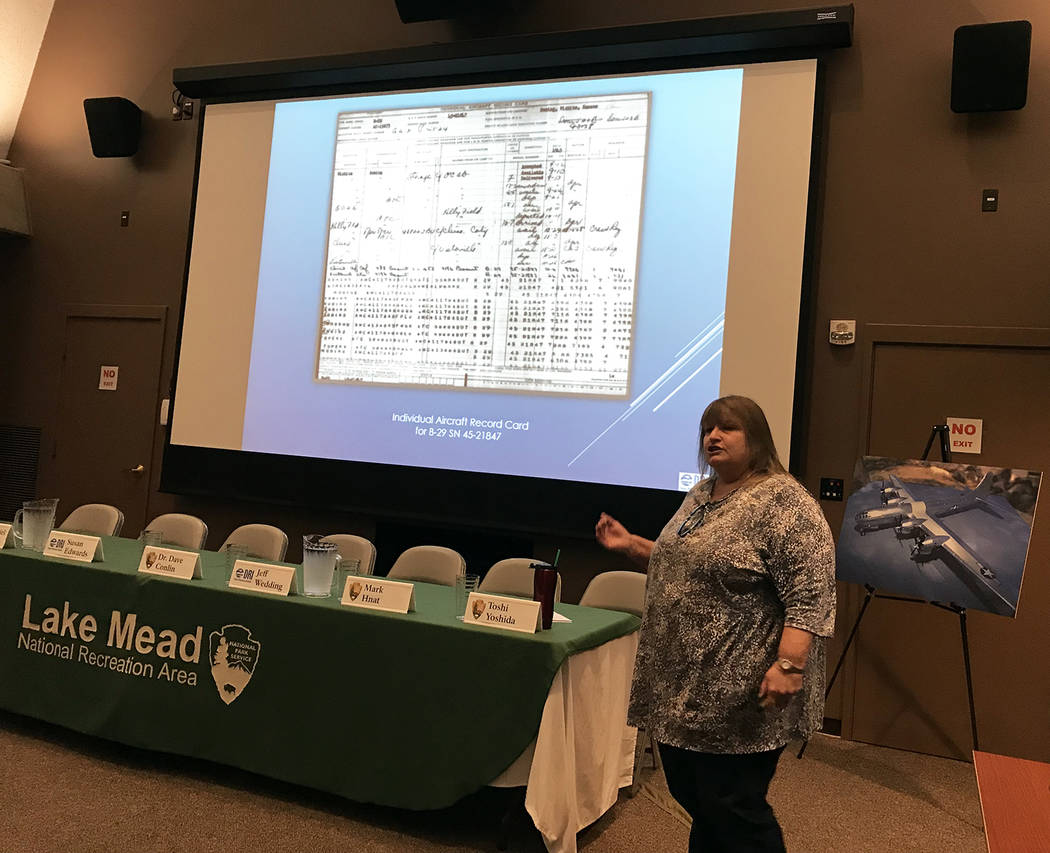Crash course in history: Story of B-29 at bottom of Lake Mead shared
“It was terrifying. It was very scary, very deep and very dark,” said Dr. David Conlin about his first dive to the B-29 Superfortress bomber that rests at the bottom of Lake Mead.
But once he got to the bottom, his fears dissipated as he spotted the plane.
“It was so very exciting to see it resting on the bottom in beautiful condition. It was better than I expected.”
Peeking inside the cockpit, Conlin, chief of the National Park Service Submerged Resources Center, said he was able to see headphones resting on the pilot’s control panel and a parachute.
“It was incredible.”
During a program Saturday to mark the 70th anniversary of the July 21, 1948, crash, Conlin spoke about how the plane was discovered and what the center is doing to protect and preserve it.
There were also presentations about the aviation and military history of the plane, and details about the plane’s mission and crew.
Susan Edwards, a research archaeologist and historian with the Desert Research Institute, said the plane was flying over Lake Mead as part of Project Apollo, a project by California physicist Dr. Carl Anderson, who was studying upper atmospheric conditions for a ballistic-missile guidance system.
According to Edwards, the B-29 Superfortress was destined to be cocooned after the end of World War II until Anderson contacted the Navy to obtain a plane that was big enough to house all of the equipment he needed for his tests.
On that day in 1948, the plane flew over the Grand Canyon and was on its way back to Naval Air Weapons Station China Lake in California when it flew low over Lake Mead to gather data from lower altitudes. An incorrectly set altimeter and glassy conditions on the lake caused it to crash, she said.
“As far as we know, all the data that was gathered that day was lost.”
Divers found wreckage
The exact location of the wreckage was unknown for decades. Conlin said it was discovered by a group of local divers with a sonar device typically used by fishermen. The divers refused to disclose the site because they wanted to salvage the plane and sell it, Conlin said.
Instead, he worked with employees from the Bureau of Reclamation, enhancing their surveys of the bottom of the lake until they saw the outline of the plane.
After figuring out the logistics to ensure everyone would be safe diving to depths of more than 200 feet, they “launched a fleet” for their first dive.
“It looked like a spaceship. It was the coolest thing I have ever seen underwater,” he said.
Conlin said he was so excited when he saw the plane that he screamed and yelled to his fellow divers, but because of the mix of oxygen and helium needed to avoid complications from diving so deep, “I sounded like Donald Duck.”
Since that first dive in 2003, Conlin has visited the wreckage about 75 times to check on its condition. Because it crashed within a national park, the plane is being protected as other natural resources within its 1.5 million acres.
“It does not belong to the Park Service; it belongs to the American people. It’s an incredible piece of history, Cold War history and World War II history,” he said.
As the lake’s level has dropped, dives to the wreckage site have become less challenging, Conlin said, adding that it also is allowing more sunlight to penetrate the water, which has increased the amount of algae.
“The colder and darker the water, the better for preservation. It’s still well-preserved, but it would be better preserved with more water,” Conlin said.
The plane also has become a place for the invasive quagga mussel to attach itself, said park biologist Toshi Yoshida.
“Its impacts are unknown, but we do know they have a strong thread system that embeds into the substrate,” he said.
Film debut
One of the program’s highlights was the debut of a film about the plane, efforts to find it and its significance to history and Lake Mead. Watching the film was almost like going on a virtual dive to the crash site.
“The movie was incredible,” said Boulder City resident Lori Merrell. “Growing up here I had heard stories of the crash and wanted to learn more.”
She said that after seeing the film she could fully understand the experience that Conlin had diving to the crash site.
“It had to be the experience of a lifetime,” she said.
“The film gave the perspective of what they see (when diving),” said Joyce McFarlane, who was visiting from Wichita, Kansas, where, coincidentally, the plane was built.
“My cousin Bob said we’re going to a thing to learn about what’s under the lake; I didn’t realize a plane was what’s under the lake.”
McFarlane was in Henderson to visit her cousin, Bob Dougherty, and his wife, Darcy.
The Doughertys heard about the program while attending a mixer at the visitor center for the Boulder City Chamber of Commerce and thought it would be interesting.
He said he wasn’t disappointed.
Those who were unable to attend Saturday’s event can watch the 10-minute film on Lake Mead National Recreation Area’s Facebook and YouTube pages. The YouTube page can be found at https://youtu.be/tXbwEpTfIkk.
Hali Bernstein Saylor is editor of the Boulder City Review. She can be reached at hsaylor@bouldercityreview.com or at 702-586-9523. Follow @HalisComment on Twitter.




















